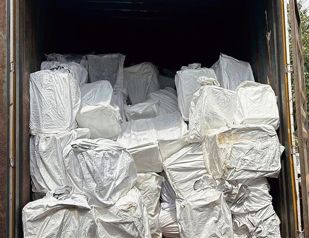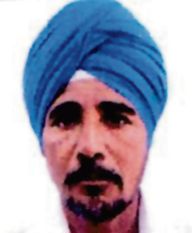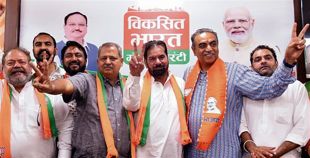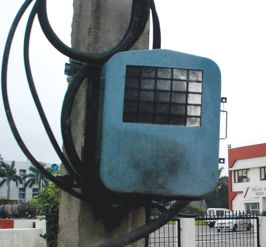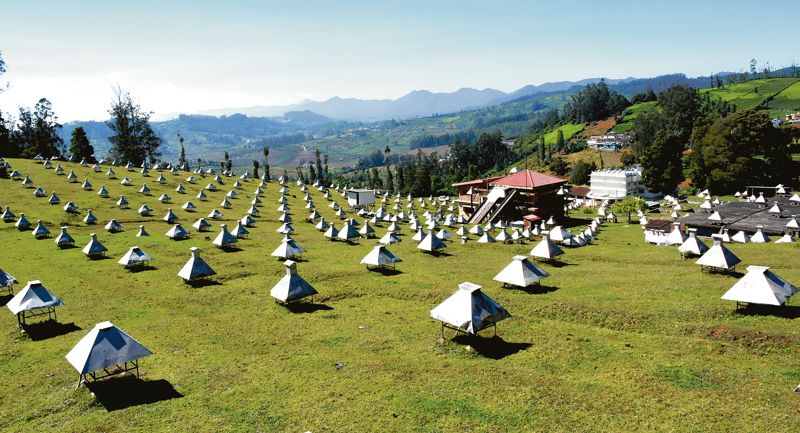
In the limelight: An array of detectors of GRAPES-3 experiment at Ooty for recording extensive air showers triggered by high-energy cosmic rays. File photo
Arun Kumar Grover
Former Vice-Chancellor, Panjab University
INDIA has had a rich tradition of solar research since the appointment of HF Blanford as the first Director General of the India Meteorological Department (1875-89). He had proposed in 1881 that accurate records of the sun’s heating power on the earth’s surface, its periodic variations and the monsoon patterns in India be maintained. Ruchi Ram Sahni, the pioneer of popularisation of science in Punjab, was the first native officer inducted in 1885 as the Second Assistant Meteorological Reporter to work under Blanford, when he was the Imperial Meteorological Reporter posted at Shimla.
The Kodaikanal Solar Observatory (KSO), the successor to the Madras Observatory, came into being in 1899; it was here in 1909 that British astronomer J Evershed discovered an effect in solar astronomy that bears his name — ‘Evershed effect’. Evershed had offered a position to KS Krishnan to work at the KSO, but he proceeded to Calcutta to work with CV Raman. Krishnan was the co-author of the research paper with Raman on the discovery of the ‘Raman Effect’ in 1928. The Government of India had issued a postage stamp in December 2008 to commemorate the centenary of the ‘Evershed Effect’. The Indian Institute of Astrophysics (IIA) in Bengaluru, established in 1971 by subsuming the observatories at Kodaikanal and Kavalur, has built the Visible Line Emission Coronagraph, one of the main payloads of Aditya-L1.
The space-bound Indian observatory mission, Aditya-L1, is expected to reach its destination, where the gravitational force of the earth balances that of the sun, early next year. After induction into a halo orbit at L1, it would commence observations that could last five years or more. The Indian mission comprises seven payloads to observe the photosphere, chromosphere and the outermost layers of the sun. However, the strategic task assigned to it is to study the space weather, ie, the unpredictable spikes in the magnetic field caused by the charged particles ejected as coronal mass ejection (CME) by the sun. Such CMEs act as supersonic electromagnetic weapons launched by the sun in random directions, which sometimes get targeted towards the earth. Their destructive power weakens as they travel and expand, but often carry enough intensity to pose a threat to our technology-dependent civilisation by destroying communication and remote-sensing satellites orbiting the earth, and damaging high-voltage electrical grids on the ground. The only protection from this devastation is a complete global electric shutdown.
The sunspot activity is known to follow an 11-year cycle; this activity would reach the next extremum around 2026, when Aditya-L1 would be operating. The National Aeronautics and Space Administration (NASA) has been monitoring the space weather by stationing multiple satellites at L1 for about three decades. On June 22, 2015, NASA received a warning of a ‘severe’ solar storm from its satellites. In October 2016, then US President Barack Obama had issued an executive order directing NASA and other government agencies in the US to prepare for such emergencies. The UK reckons adverse space weather as one of the most serious natural hazards in its National Risk Register.
It is serendipity that an Indian cosmic ray experiment named GRAPES-3 (Gamma Ray Astronomy at PeV EnergieS-Phase 3) discovered the ‘transient weakening of the earth’s magnetic shield’ that correlated with the solar storm of June 22, 2015, which was published in Physical Review Letters, one of the most prestigious journals of physics, in 2016. This Indian work also showed that the earth’s magnetic field acted as a brake on this storm, reducing its speed of 700 km/second at L1 to 35 km/second, thereby causing an additional delay of 30 minutes. Accurate storm arrival time on the earth is vital to minimise the economic losses during a global shutdown.
The discovery established GRAPES-3 as one of the world’s most sensitive instruments for studying space weather. It had triggered an avalanche of attention by the global media on the Ooty experiment, with over 1,000 reports appearing in 37 languages in 119 countries. Anil Kakodkar, former Chairperson of India’s Atomic Energy Commission, had called for according high priority to independent research on space weather. The group leader of GRAPES-3, Prof SK Gupta, was elected Chairman of IUPAP (International Union of Pure and Applied Physics) Commission C4 on Astroparticle Physics during the General Assembly of IUPAP in 2017. Earlier this year, he was honoured with the prestigious O’Ceallaigh medal during the 38th International Cosmic Ray Conference in Nagoya, Japan.
Indian participation in cosmic ray research had commenced in 1926 with the visit of Prof AH Compton (Nobel Prize in physics, 1927), following an invitation from the University of the Punjab at Lahore for collaborative research. JM Benade, SS Bhatnagar and Nazir Ahmed from Lahore had accompanied Compton’s team to measure the intensity of cosmic rays while lowering an ionisation detector to the bottom of a lake near Gulmarg. Homi Bhabha, then an intermediate student, had got inspired to pursue a career in physics via a lecture delivered by Compton in Bombay in 1926. In 1931, the first successful experiment that established cosmic rays as charged particles was carried out at different latitudes across India by Compton and his Indian collaborators, Benade and R Wilson of Forman Christian College, Lahore, and geologist George Roerich of Urusvati Himalayan Research Institute at Naggar (near Manali, Himachal Pradesh).
In 1955, Bhabha inspired his student, BV Sreekantan, to set up the Cosmic Ray Laboratory of Tata Institute of Fundamental Research (TIFR) in Ooty, where the GRAPES-3 experiment continues as an India-Japan collaboration. Bhabha is often remembered for his prophetic words: “All fundamental research could one day become useful.”
Join Whatsapp Channel of The Tribune for latest updates.






















